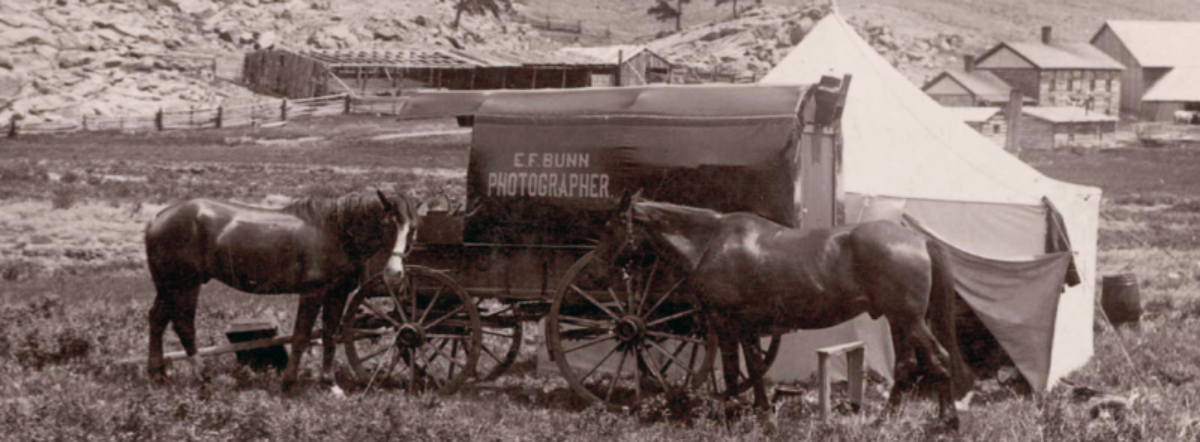History lovers, help me solve a mystery! This blog post has been simmering for months because I was fascinated by one photo–the charming group portrait in front of the log cabin. If you look closely, there is a sign above the door that reads “Willa Catha Hotel.” I immediately thought of the author, Willa Cather, but she was a young girl living in Nebraska when this photo was taken. Share your thoughts!
Augustus W. Dennis was born on December 29, 1858 to Selah G. Dennis and Bethiah Thorndike Dennis in Rockland, Maine. The youngest of six boys, he attended school in Hallowell, Maine. In 1869, Selah, now a widower, moved his family to Melrose, Massachusetts, a short ten miles north of Boston. The following year, twelve-year old Augustus was severely injured when he was thrown from a wagon. Unable to find adequate medical care in Massachusetts, Dennis traveled to London’s famous St. Thomas Hospital. Dennis spent five years in London recovering from his injury. He returned to the U. S. in 1876, settling in Austin, Minnesota.
In Austin, Dennis learned photography from a Mr. Peck. They worked together as Peck & Dennis until January 1879, when Dennis took sole proprietorship of the gallery. In November 1879 he sold the Austin gallery and briefly relocated to Faribault, Minnesota. He left for Colorado in a covered wagon in April 1880.
Dennis arrived in Canon City, Colorado where he took possession of E. G. Morrison’s photo gallery on Main Street, and sold Morrison’s stereos of Colorado scenery. He also maintained the city’s free reading room. The library contained more than 150 books and seventy-five newspaper titles. For ten cents a week, patrons could take books home to read.

In March 1881, Canon City photographer J. A. Boston retired and sold his instruments, negatives and stock to Dennis. Due to an increase in business, Dennis hired several assistants, including Thomas J. Colpas, from Kansas City, to work in his gallery. In June 1881, Dennis set up a temporary studio at Colorado’s first state penitentiary to document convicts, recording their likenesses in the event of their escape. Dennis also made a series of photographs of the Denver & Rio Grande Railroad. In addition to photographs, Dennis sold rattan furniture and pianos in the gallery.
In February 1883, Dennis added a partner, William E. Few. They operated as Dennis & Few through 1885. Few would later work with Dennis in Glenwood Springs, where Dennis relocated around 1886. His first Glenwood studio consisted of a tent north of the river. Later he moved to permanent quarters on Blake Avenue. Dennis used the dry instantaneous process to photograph local scenery. In November 1892, Dennis traveled to Mexico on official business to photograph government documents related to the Mexican land grant of 1838. He lived in Glenwood Springs through the early 1900s, serving as the city’s mayor in 1892.


Dennis photographed the development of Glenwood’s hot springs, now the world’s largest hot springs pool. Located along the Colorado River in Glenwood’s downtown area, the hot springs began operation in July 1888.


While Dennis announced in November 1902 that he and his wife were moving to California for his wife’s health, it seems that they relocated to Pueblo, Colorado, naming his business the Rembrandt Studio. In December 1904, Dennis advertised the sale of his Pueblo studio due to his wife’s illness. They removed to Long Beach, California where Mrs. Dennis passed away in August 1905.
Dennis returned to Glenwood Springs in 1906, becoming a cattle rancher. He died on July 24, 1927, Glenwood Springs. He was buried in Greenwood Cemetery, Canon City, next to his wife.
Thank you to Carolyn Cipperly, Archivist, Glenwood Springs Historical Society, for research help and Beverly W. Brannan for proof reading this post. Roger Genser confirmed the attribution of Dennis’ Canon city street scene. The Peter E. Palmquist Memorial Fund for Historical Photographic Research provided funds for the scans from the Glenwood Historical Society.

Fascinating bio, well done!